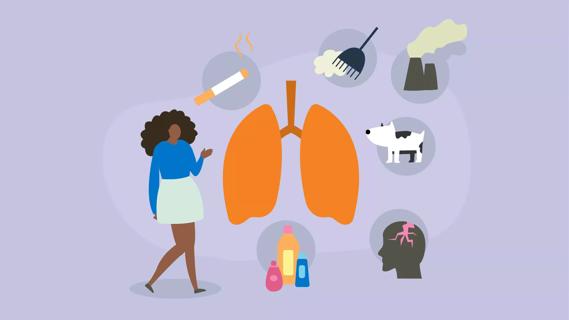Being prepared is key when you have asthma

If you or a loved one has asthma, you know the stress of an unexpected asthma attack. That’s why taking preventive measures against an attack is key. A helpful step is to create an asthma action plan with your physician.
Advertisement
Cleveland Clinic is a non-profit academic medical center. Advertising on our site helps support our mission. We do not endorse non-Cleveland Clinic products or services. Policy
“It’s important for individuals to understand what their symptoms are and what they have to do if they’re getting worse,” says pulmonary medicine specialist Nirosshan Thiruchelvam, MD. “It’s also important to work with your care provider to improve your symptoms rather than allowing them to get worse.”
To create an asthma action plan, you’ll need the right resources, steps and knowledge. The plan will prepare you in case of an attack, as well as improve your day-to-day life. This plan can serve as a tool for not only you as an individual with asthma, but also for your caregivers and physicians. For parents, it’s also an important resource for your child’s school nurse and teachers.
According to the American Lung Association, an asthma action plan is a step-by-step worksheet that lays out ways to prevent your asthma from becoming too severe. It also includes what to do in case of an attack. You can create a plan for both adults and children, with special versions that you can create specifically for use in schools and preschools.
Your plan should also list your immunization history, including the dates you received your flu and COVID-19 vaccines.
Asthma plans usually include contact information and a list of medications that are divided into traffic colors or “zones” (usually color-coded in green, yellow and red). These zones help determine what steps to take depending on the severity of your symptoms. These zones represent “Go,” “Caution” and “Danger.”
Advertisement
“The action plan is important to bring you back to the green zone,” Dr. Thiruchelvam says. “So rather than getting worse, you’re getting better.”
Your asthma action plan should include important contact information, including your name, the name and phone number of your emergency contact, and your doctor’s information. It should also include the date your plan was created, so anyone reviewing will know how current it is.
Go (green): The green zone lists the medications you take daily to control your asthma. This means that with these medications, you’re able to:
The green zone will also list what medication you should take if you have exercise-induced asthma.
Caution (yellow): The yellow zone lists additional steps you should take, on top of continuing all of your green zone medications. Follow these steps if you have:
In addition to taking your yellow zone medications, you should call your asthma care provider.
Danger (red): If your asthma continues to worsen even after you’ve taken the medications outlined in your green and yellow zones, you enter the red zone of your asthma action plan. This section lists additional medications you should take when:
In addition to taking the medications listed, in this stage of the plan, you (or whoever is following the plan on your behalf) should contact your doctor immediately, and if you can’t make contact, go directly to an emergency room.
The different stages of your asthma plan make it clear what medications to use and what additional steps to take based on your symptoms. Your asthma plan takes any guesswork out of deciding what to do when you or someone you’re providing care for has an asthma attack. The plan is personalized to your needs.
Because a plan isn’t one-size-fits-all, you’ll fill in the different zones of your personal asthma plan when you see your physician. This can and should be updated during every office visit to monitor any improving or weakening symptoms.
“It’s going to be a living document, so it’s not going to be set in stone,” Dr. Thiruchelvam points out. “Your controller medication might be different. You know, things might change.”
Here’s some plan information that’ll look different for everyone:
Advertisement
One section should include a list of symptoms to identify. Based on those, your doctor fills out the appropriate steps to take. Depending on the triggers, your symptoms and previous steps taken, each zone lists certain medications and actions to take.
“Individualized care is key,” says Dr. Thiruchelvam. “Especially when you’re treating asthma, there are two different paths. One is avoiding triggers and the other is treating the disease.”
Take these steps to follow your plan:
An asthma action plan lays out steps to take in preparation for a possible attack. But the 4:4:4 rule is also important to know for children having an active attack. This shortcut will help you remember the specifics for helping a child use their inhaler during an attack. When a child is showing shortness of breath, tightness in their chest, wheezing or other severe symptoms of asthma, follow the 4:4:4 rule:
Advertisement
By creating an asthma action plan and knowing the 4:4:4 rule, you can be confident you’re prepared for a possible asthma attack. Keep this plan ready and available at home, at your physician’s office and at any school or daycare center for children.
Advertisement
Learn more about our editorial process.
Advertisement

The effectiveness and safety of many of these options are unknown, so it’s best to stick to traditional care

Avoid triggers like dust, smoke and cold air to lessen your chances of coughing

Developmental changes like puberty and menopause can impact symptom severity

Symptoms may lessen over time, but the condition never truly goes away

Some tips to make your next fire safer

A rainy day can spell pain and discomfort for many

Key tip: minimize your exposure

Plus, 7 ways to avoid asthma attacks during cold weather

Type 2 diabetes isn’t inevitable with these dietary changes

Applying a hot or cold compress can help with pain